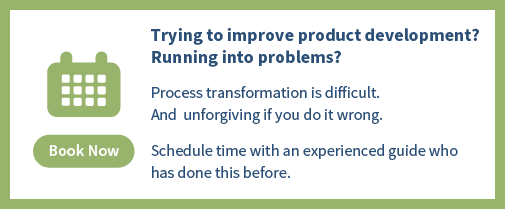Agile development
Yes, Agile principles can be applied with benefit in hardware product development (Agile hardware development). However, Agile's principles on their own miss the mark in terms of a complete solution for hardware product development. So let's look at Agile and how hardware development is different than software development.
Agile Manifesto
The Agile Manifesto, first developed in 2001, has revolutionized software development. The principles, tools, and practices which have stemmed from it have been refined and spread through many software development companies. In the world of software, Agile consultants and development tools are multiplying like rabbits.
Hardware vs. software development
The rapid growth of Agile development is understandable because there are huge financial and cultural improvements realized by implementing Agile in software development. Yet, in hardware product development, Agile principles, tools, and practices have been slow to take hold.
Why is that?
Software product development and hardware product development are different.
That is not to say that there are not similarities. Just as Lean Manufacturing has some commonalities with Lean product development, Agile software development has some commonalities with Lean hardware product development.
Some examples include the value of faster feedback and earlier learning enabled by smaller batches (see the posts in the Lean Startup series), test driven development, daily stand-up meetings, and visual work management. In many cases, a hardware team striving to be more Agile is moving in the right direction -- Agile hardware development.
Interested in understanding more Lean-Agile Principles? Check out our free Lean-Agile training on Playbook Academy such as Rolling-Wave Planning, Applying Agile to Hardware and Critical Chain.
However, just as there are critical differences between Lean manufacturing and Lean product development, there are critical differences between Lean software development and Lean hardware development.
Lean manufacturing practices can do more harm than good if blindly applied to new product development. The same is true of applying Agile to hardware.
It is time we saw the differences clearly and built our software and development systems to operate Leanly under these different conditions.
Top 3 differences in hardware vs. software development
Just to get us started, I will mention what I see as the ‘top 3’ differences. These have huge impacts on how we plan, manage, and execute our product development projects.
-
Procurement Lead Time
Where software teams have a relatively short ‘compile’ step which resides within the Design-Build-Test cycle, hardware teams have a relatively long ‘procure’ step. Driving down the length of the procure steps is a key initiative in Lean NPD today, but we are not, nor will we be anytime soon, anywhere close to procuring parts and building assemblies in the few minutes it takes to compile software. From the first day of a new project through its last minute changes, lead time is ever present and highly impactful. This simple fact changes a lot about what we do and how we do it.
-
Component Cost
Software development is almost all labor cost. It isn’t difficult or expensive to give everyone full access to the latest and greatest version of the software for them to test. However, in hardware development, it costs a lot to give everyone who needs it access to the latest and greatest hardware, and it takes longer to deliver those units. Like lead time, component cost changes what we should do for maximum profit.
-
Non-homogenous Work
Where software teams are comprised of several different skill sets such as marketing, design, a few different fields of development, and quality, hardware teams are typically comprised of these and a great many more. In addition to the software increasingly present in new hardware products, there are often molded components, optics, sheet metal, castings, cabling, piping, circuitry, assembly, and packaging skills needed by different people who must stay in sync during product development. There are other additional skills needed in hardware development such as the research scientists, supply chain, manufacturing, receiving/inspection, and field service not typically involved in a software project. The list goes on and on.
The complexity of the communication channels and keeping everyone in sync on such a necessarily large team, like component lead time and cost, changes what we do in hardware product development.
Related articles
Agile Development
Applying Agile Values to Hardware Development
Agile Principle 1: Early and Continuous Delivery of Value
Agile Principle 2: Welcoming changing requirements
Making Hardware Development More Agile
Early Learning in Hardware Development
Agile Principles 4 - 12 to Hardware Development
Guide to Kanban
Guide to Applying Agile to Hardware Development





